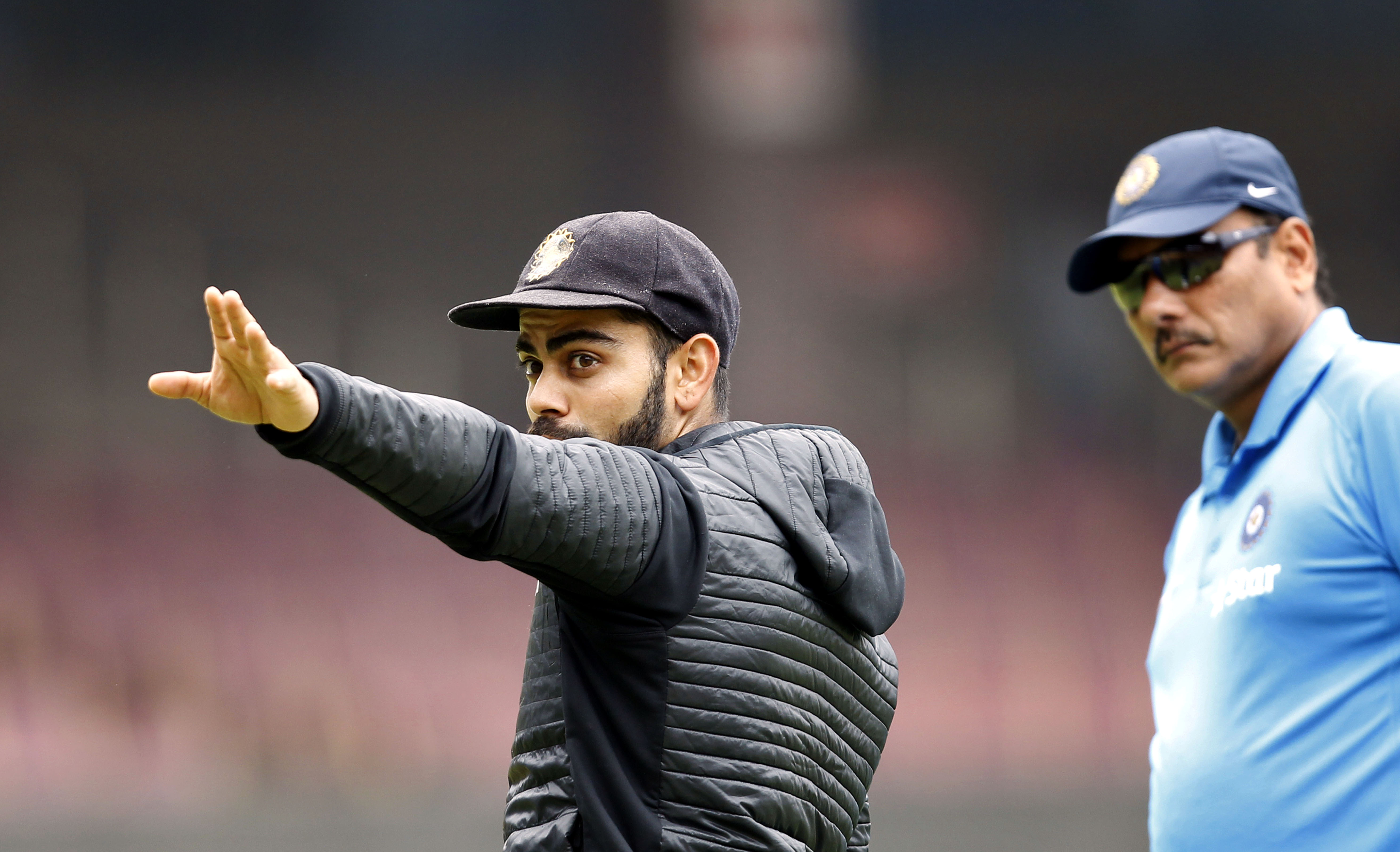Has Ravi Shastri come close to what Anil Kumble achieved as an Indian coach
And just like that, Virat Kohli smashed the South Africans in the ODI series and led India to an unprecedented 5-1 win in the Proteas own background. Not only did India outmanoeuvre a depleted SA from the pinnacle to achieve the Numero Uno status in the rankings, they did in some style as well.

But with the T20 series beginning today, now the business has become as usual. Because this is Kohli’s India. The new India that doesn’t care about “reputations, tags, or headlines” or doesn’t want to bask in the afterglow of historic series victory. The India that doesn’t care about what people outside the set-up of the team management think about them. They have convinced themselves that their only job is to perform and take the flag of Indian cricket onwards and upwards.
It is Kohli’s India that dictates terms. It doesn’t bow down to BCCI pressure or any state association lobby. It respects talents and nurtures them for bigger challenges that lay ahead. Because this is the new India. It's Kohli’s India. He takes the burden on himself when everyone fails. He can chase down any target from a scarcely believable position. A modern-day genius, they said and he lived up to that.
Ramachandra Guha, a former member of the Supreme Court-appointed Committee of Administrators, pointed out in a blog for the Kolkata Telegraph, “In Indian cricket today, the selectors, coaching staff and administrators are all pygmies before Kohli” and everyone wants to be in his good books. And why wouldn’t they?
When a man defies logic to score a series tally of 558 runs at an insane average of 186, the highest aggregate in a bilateral series, it is only natural to be in the awe of him. And Ravi Shastri, the motivator extraordinaire first and a coach second, said people should start visiting a bookstore and pick up the Oxford dictionary to find superlatives for the Indian skipper and he couldn’t have been more right.
With Kohli taking a step forward on his way to establishing a legacy for himself, the Indian team is also finding themselves at the pinnacle, mostly down to one man at the helm of the team - their captain. With Kohli, Shastri is also, slowly and steadily, taking a step forward to be considered as one of the finest coaches that the Indian team has ever had alongside Ajit Wadekar, John Wright, Garry Kirsten, and Anil Kumble. But with the human mind being infatuated with comparisons all the time, it is only fair to compare the two immediate predecessors and successors and their achievements during the period they were in charge of the team.
Kumble, as a cricketer, was meticulous and someone who believed in substance over style and above all else paid extraordinary attention to detail. He brought the same nature to his coaching manual and in the one year, that he was in charge of the Indian team, he instilled a competitive culture in the current generation to never settle for mediocrity and galvanised a young team into an aspiring team of stars. He was a born leader with extraordinary grit and was a perfect foil to Kohli’s aggressive attitude, they said.
India’s two spinners, Ravichandran Ashwin and Ravindra Jadeja seemed to benefit most from having the privilege of picking Kumble’s ridiculously experienced and brilliant mind. While the
As much as the perfect results, it was India’s approach towards the game and the desire to blood young talent that stood out during the legendary leg-spinner's tenure. While Kumble is glorified just because he is "the Anil Kumble", it is also worth noting that he was also driven towards the all-round development of the players and youngsters like Karun Nair and KL Rahul shone under his guidance. There was also an enhanced emphasis on fitness and those who went out of the side due to injury concerns, they were required to prove their fitness by playing domestic games before they could be eligible for consideration for the senior side. After Kumble’s insistence on a regimental work ethic and Kohli’s personal discipline, Indian cricketers even started eating Japanese cuisine and it was clear that fitness wasn’t a bugbear for Kohli, nor for any other member of the Indian team.

 © Getty
© GettyHowever, for reasons best known to Kohli and Kumble, the "match-made-in-heaven" went dead south towards the final stages of his stint due to an apparent disagreement between the skipper and the coach. Both were strong-willed professionals and there is no doubt that two high-achieving individuals wouldn’t have agreed on every single issue, but it was sad that Kumble’s achievements as a coach were nipped in the bud with the fiasco and the talks of the comfort of the home conditions. After Kumble’s resignation, Ravi Shastri, Indian cricket’s forever crisis man, beat Virender Sehwag, Tom Moody, Richard Pybus, and Lalchand Rajput for arguably the biggest role in world cricket and since taking over, it’s been honky-dory for the Indian team apart from a blip in the Test series against South Africa.
Shastri should indeed be credited for helping Indian team become a better side than before and players like Chahal and Kuldeep started flourishing under him, but the fact that roles of their numbers 4, 5, 6 and 7 are in mystery, takes the sheen away from Shastri’s effort. While India’s batting triumvirate – Rohit Sharma, Virat Kohli, and Shikhar Dhawan – have been in a terrific form for a long time, there has been no tangible development in the middle-order area that first came to haunt India in Champions Trophy final against Pakistan. India, without a shadow of a doubt,
Even when some of Kohli’s decisions were under scrutiny, Shastri seems to have failed to guide the skipper behind the scenes. Although there is no doubt about the fact that the captain leads the troops to battle on the field, the role of the coach in cricket, as Kumble suggested, is “to hold a mirror” and the first ODI in Durban was a clear example that Shastri failed to do so.
With the pitch being slower than a normal Durban pitch, India decided to play both their wrist-spinners and the part-time option in Kedar Jadhav. And it proved to be a good decision as the ball stayed low and spinners got enough purchase off the wicket and moreover, started a parsimonious spell. The entire South African top-order, albeit Faf du Plessis, failed to understand their deliveries and as a result, the team were reduced to 134/5 in 28 overs.
Logic dictated that the spinner would be given another couple of overs to build on the momentum, but instead, Kohli handed the ball to Jasprit Bumrah. That move allowed du Plessis and Chris Morris to settle down on the wicket to form a partnership of 64 runs. While there had been numerous drinks breaks in between, a message from the change room would have been largely beneficial in the context of the game and the match would have been an easier an affair for the batsmen.
Indian cricket, for years, has been blessed with some finer tacticians and man managers like Wadekar, Wright, and Kirsten, with all leading India close to World beaters, but Shastri, who has been blessed with probably the finest team of them all, just needs to refine the finer points and shouldn’t make himself a one-dimensional coach.
Although the way the Kohli-Kumble saga played out in the public eye was enough to instil fear in anyone who could even dream of going up against the powerful Indian skipper, the dressing room must be a sacrosanct place where ideas are discussed and challenged in the right spirit. Shastri doesn’t need to be going against Kohli’s whims and fancies, but, he is there to advise the team, who are years younger in cricketing experience than him. More than the blatant results, a proper moulding will be crucial in deciding Shastri’s legacy in his second-coming as the Indian backroom staff leader.

Comments
Sign up or log in to your account to leave comments and reactions
0 Comments